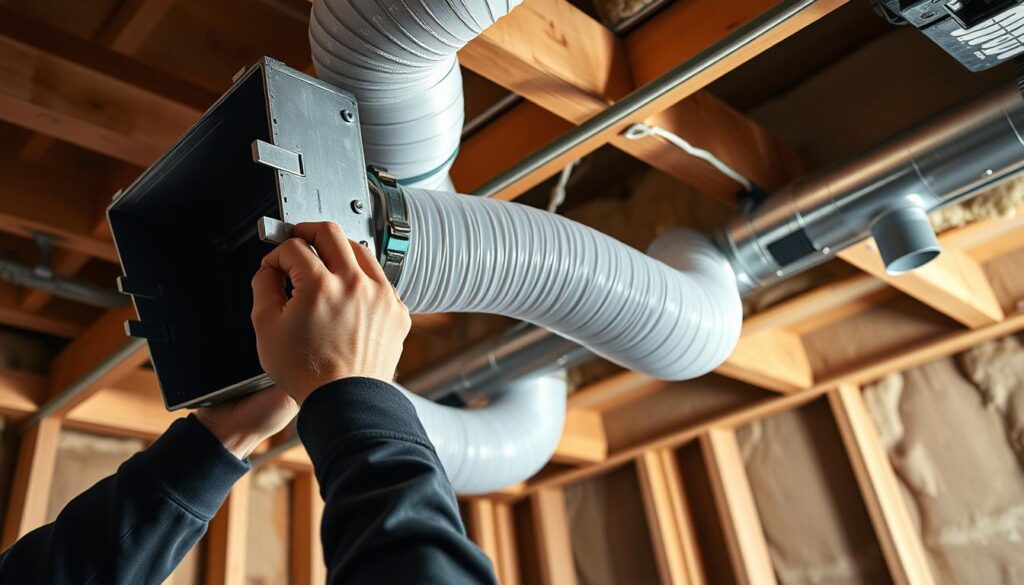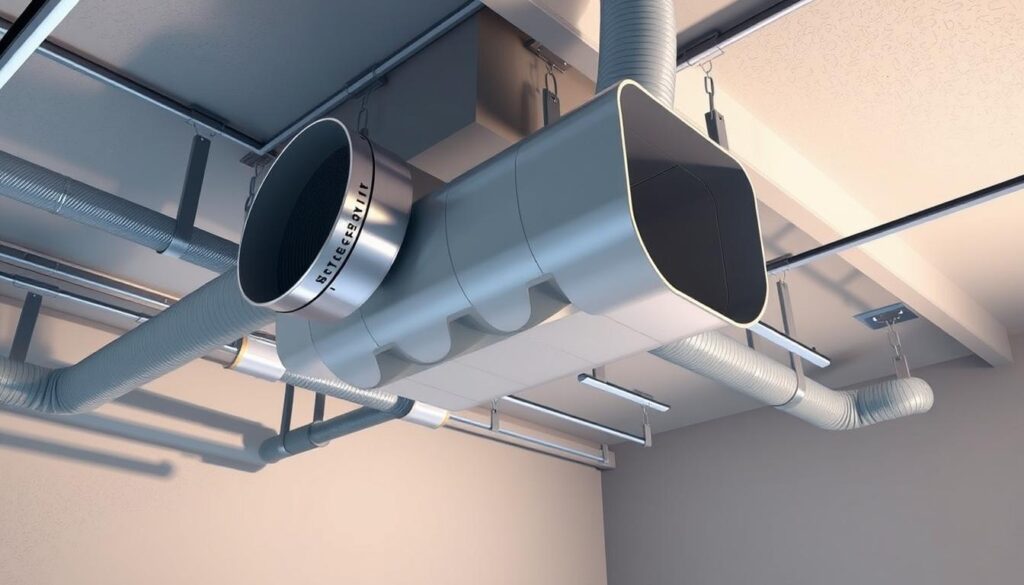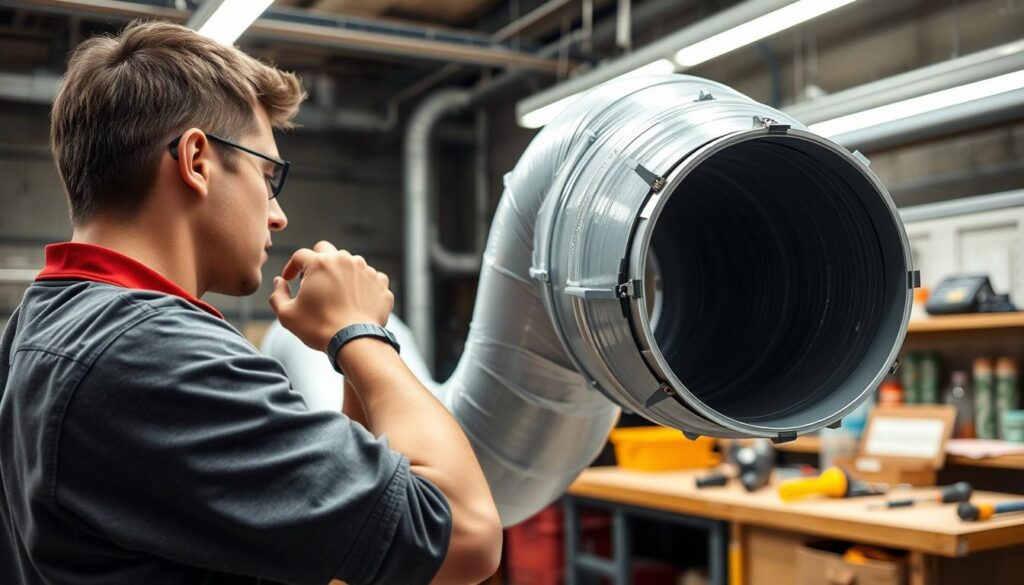Affiliate Disclosure
HVAC Guide Guys is a participant in the Amazon Services LLC Associates Program, an affiliate advertising program designed to provide a means for sites to earn advertising fees by advertising and linking to Amazon.
How to Attach HVAC Flex Duct? Are you having trouble figuring out how to install flexible ductwork in your HVAC system? What if you could learn to attach HVAC flex duct like a pro?

Flex duct is key in heating, ventilation, and air conditioning systems. These flexible tubes help air flow well in homes and businesses. They are vital for keeping the climate just right.
Installing these ducts needs care and skill. Done right, they make your HVAC system work better and save energy. This guide will show you how to install flexible ductwork with ease.
Key Takeaways
- Understand the importance of proper flex duct installation
- Learn critical techniques for attaching HVAC flex duct
- Recognize the role of flexible ductwork in HVAC systems
- Discover best practices for optimal air circulation
- Prevent common installation mistakes
Table of Contents
Understanding HVAC Flex Duct Basics
Flex ducts are key in modern HVAC systems. They bring flexibility and efficiency to homes and businesses. These air distribution solutions are gaining popularity among HVAC experts and homeowners.
Knowing the basics of secure flexible air ducts is crucial. It’s important for a successful installation and the best performance.
Types of Flexible Ductwork
There are different types of flexible ductwork, each for a specific use:
- Insulated polyester flexible duct
- Foil flexible duct
- Semi-rigid aluminum flexible duct
- Silver-lined flexible duct
Benefits of Flex Duct Installation
Installing flex ducts has many benefits for HVAC systems:
- They fit well in tight spaces
- Installation is simpler
- They keep heat in better
- They save money
Common Applications in HVAC Systems
Professionals use flex ducts in many situations:
- Attic installations
- Crawl spaces
- Complex architectural layouts
- Retrofit HVAC projects
Learning about these installation techniques helps you make better choices for your HVAC system.
Essential Tools and Materials for Installation
Getting ready to connect flexible ductwork means picking the right tools and materials. Knowing what you need and why is crucial. It’s what makes a pro’s job easier.
- Tape measure for precise measurements
- Utility knife with sharp blades
- Metal crimping tools
- Protective work gloves
- Safety glasses
- Marker or permanent pen
Here’s what you’ll need for materials:
- Flexible ductwork that fits your system
- Duct tape made for HVAC
- Metal support straps
- Insulation wrap
- Sealant for duct sealing
“Quality tools are an investment in successful HVAC installation.” – HVAC Professional Handbook
| Tool Category | Recommended Items | Purpose |
|---|---|---|
| Measuring | Tape measure | Ensure accurate duct length |
| Cutting | Utility knife | Precise flex duct trimming |
| Fastening | Metal clamps | Secure connecting flexible ductwork |
Pro tip: Always check your tools before starting. Make sure they’re in good shape and right for your HVAC system.
Explore Our HVAC Shop
Looking for top-rated HVAC tools, parts, and accessories? Visit our shop and find the perfect solution for your needs.
Visit the ShopSafety Precautions Before Starting
Working with HVAC systems needs careful preparation and strict safety rules. Before attaching flex duct to register, it’s key to know and follow safety steps. This protects you and makes sure the installation goes well.
Personal Protective Equipment Requirements
It’s vital to protect yourself when working with flex duct. Your safety gear should include:
- Safety glasses to shield eyes from debris
- Work gloves to prevent cuts and abrasions
- Dust mask to avoid inhaling particles
- Long-sleeved shirt and pants for skin protection
- Steel-toed boots for foot safety
Workspace Preparation Guidelines
Creating a safe work area is crucial for successful flex duct installation. Follow these steps to prepare your workspace:
- Clear the work area of unnecessary items
- Ensure adequate lighting
- Keep tools organized and within reach
- Maintain good ventilation
- Have a first aid kit nearby
System Power Considerations
Electrical safety is a top priority when working with HVAC systems. Always follow these important power management practices for safe flex duct connection:
- Completely shut off power at the circuit breaker
- Use a voltage tester to confirm no electrical current
- Lock out the electrical panel to prevent accidental re-energizing
- Verify system is completely powered down before starting work
Remember: Your safety is the most important tool in any HVAC installation project.
How to Attach HVAC Flex Duct: Step-by-Step Guide
Attaching HVAC flex duct needs precision and careful steps. This guide will show you how to connect it properly and efficiently.
- Measuring tape
- Utility knife
- Metal clamps
- Protective gloves
- Insulation materials
Here are the key steps to attach HVAC flex duct:
- Measure Accurately: Find out the exact distance between the points where you’ll connect. This avoids putting too much strain on the duct.
- Cut Carefully: Cut the flex duct with a sharp utility knife. Make sure your cuts are clean and straight for a good fit.
- Position the Duct: Place the flex duct over the vent collar, making sure it fits well.
- Secure Connections: Use metal clamps to hold the duct in place. Tighten them well to stop air leaks.
“Proper installation is key to maintaining your HVAC system’s efficiency and performance.” – HVAC Professional
Don’t forget to support the ductwork. Use the right hangers to keep it from sagging and ensure good airflow. Use high-quality duct sealant to seal all joints and connections for better system performance.
Remember, installing ductwork needs patience and detail. Take your time to do each step right for the best outcome.
Explore Our HVAC Shop
Looking for top-rated HVAC tools, parts, and accessories? Visit our shop and find the perfect solution for your needs.
Visit the ShopProper Measurement and Cutting Techniques
Installing flexible ductwork needs precision and careful prep. The success of your HVAC system depends on accurate measurement and expert cutting. Professionals know that flex duct installation requires attention to detail and the right approach.
Measuring for Accuracy
Precise measurement is key when installing flexible ductwork. Follow these steps:
- Measure the distance between connection points
- Add 2-3 extra inches for potential adjustments
- Account for any bends or turns in the ductwork
Cutting Methods and Best Practices
When cutting flex duct, use these professional techniques:
| Technique | Best Practice |
|---|---|
| Cutting Tool | Sharp utility knife with new blade |
| Cutting Angle | Straight, perpendicular cut |
| Cutting Surface | Flat, stable work surface |
Avoiding Common Cutting Mistakes
Watch out for these potential errors during flex duct installation:
- Uneven cuts that compromise seal integrity
- Using dull cutting tools
- Incorrect measurement leading to short or long sections
By mastering these measurement and cutting techniques, you’ll ensure a professional and efficient flex duct installation. This will maintain optimal HVAC system performance.
Installing Support Systems and Hangers
When you’re working on a ductwork installation guide, it’s key to know how to secure flexible air ducts. This keeps your system running well. Proper support stops sagging and makes sure air flows right through your HVAC system.

- Consistent spacing between hangers
- Appropriate hanger materials
- Correct installation techniques
Experts say to put support hangers every 4-6 feet on the flex duct. This spacing spreads out the weight and stops the duct from sagging or getting stressed.
| Hanger Type | Best Use | Material |
|---|---|---|
| Adjustable Straps | Horizontal Runs | Galvanized Steel |
| Rigid Supports | Vertical Installations | Aluminum |
| Padded Hangers | Noise Reduction | Rubber-Coated Metal |
When setting up support for flexible air ducts, keep a slight upward slope towards the vent. This angle stops moisture buildup and prevents mold.
“Proper support is the backbone of an efficient HVAC system” – HVAC Engineering Professionals
By sticking to these tips in your ductwork guide, you’ll build a strong support system. This boosts your HVAC’s performance and life span.
Explore Our HVAC Shop
Looking for top-rated HVAC tools, parts, and accessories? Visit our shop and find the perfect solution for your needs.
Visit the ShopConnecting Flex Duct to Rigid Ductwork
Connecting flexible ductwork to rigid ductwork is key for a good HVAC system. It makes sure air flows well and stops leaks that harm your system’s work.
Attaching HVAC flex duct needs care and skill. Knowing how to connect it right makes your installation look like a pro’s.
Alignment Techniques for Seamless Connections
Here’s how to attach hvac flex duct to rigid ductwork:
- Clean both the flexible and rigid duct ends well
- Make sure they’re dust-free
- Align the flex duct straight and centered over the rigid duct opening
- Check for smooth, even positioning
Securing the Connection
Securing the connection stops air leaks. Use these methods:
- Choose the right size metal clamps
- Put clamps evenly around the duct junction
- Tighten clamps evenly for a tight seal
- Make sure there are no gaps between the ducts
Sealing Techniques
Sealing is the last step in connecting flexible ductwork. Use high-quality duct tape or mastic sealant for a tight seal. Seal the whole clamp area to stop air leaks.
Pro Tip: Always check your connections for a tight, leak-free seal.
Insulation and Vapor Barrier Installation
Proper insulation is key for your HVAC system’s energy efficiency. When using flex duct, aim for a strong thermal barrier. This protects your ductwork from extreme temperatures.
First, pick the right insulation for your HVAC. Common choices are:
- Fiberglass wrap
- Foam insulation sleeves
- Reflective foil insulation
For insulation, use a multi-step method. Wrap the flex duct fully, ensuring no gaps. Use foil tape or duct insulation tape to keep it in place. This seals the duct, stopping air leaks.
Vapor barrier installation is also vital to stop moisture. When installing, overlap seams by at least 2 inches and seal all edges completely. This stops condensation and mold in your ductwork.
Pro Tip: Always wear protective gloves and eyewear when working with insulation materials to protect yourself from potential irritants.
Important tips for insulation include:
- Keep insulation thickness consistent
- Avoid compressing the insulation
- Seal all seams and edges well
- Check for any gaps or exposed areas
By following these steps, you’ll make your HVAC system more energy-efficient. It will keep the temperature right and cut down on energy use.
Explore Our HVAC Shop
Looking for top-rated HVAC tools, parts, and accessories? Visit our shop and find the perfect solution for your needs.
Visit the ShopBest Practices for Straight Runs and Bends
Installing flex ducts needs careful attention for the best HVAC system performance. The right installation techniques boost airflow and system efficiency.

Understanding how to handle straight runs and bends is key for securing flexible air ducts well.
Maintaining Proper Tension
Getting the tension right is vital for flex duct connection best practices. Here are some important tips:
- Keep slack to a minimum in straight runs to avoid sagging
- Stretch the duct gently without overdoing it
- Use supports every 4-5 feet to keep tension even
- Avoid pulling the duct too tight to prevent damage
Avoiding Kinks and Restrictions
Kinks and sharp bends can cut down airflow and system efficiency. To avoid these problems:
- Use smooth, sweeping curves instead of sharp angles
- Keep a minimum bend radius of 1 radius diameter
- Use rigid elbows for tight turns when you can
- Check each bend carefully during installation
Pro tip: Always choose smooth air movement over the shortest route when laying out flex ducts.
Proper installation is the key to maximizing your HVAC system’s performance and longevity.
Testing and Quality Control Measures
After finishing your ductwork installation guide, it’s time for thorough testing. This step is key to making sure your system works its best. It checks if your hvac duct sealing methods and installation are up to par.
Your testing should cover a few important areas:
- Static pressure measurement
- Airflow assessment
- Leak detection
- Connection integrity verification
Start by checking the static pressure with a special gauge. This shows how well air flows through your ducts. If the readings are off, it might mean there’s a blockage or installation problem that needs fixing right away.
Next, do a detailed airflow test. This makes sure your system sends the right amount of air to each room. Use an anemometer to check air speed and volume at different spots. Then, compare these numbers to what the maker says they should be.
Leak detection is also a must in your quality control steps. Use a smoke test or special leak finding tools to spot any air leaks. Fix any leaks you find to keep your system running smoothly.
Remember, proper testing can stop problems later on and make your HVAC system last longer. Take the time for detailed quality control to get the best results.
Explore Our HVAC Shop
Looking for top-rated HVAC tools, parts, and accessories? Visit our shop and find the perfect solution for your needs.
Visit the ShopCommon Installation Mistakes to Avoid
Even pros can face challenges when installing flex ductwork. Knowing common mistakes can help avoid costly errors.
Attaching flex duct to register needs careful attention. Avoiding common mistakes is key to your HVAC system’s efficiency.
Poor Support Challenges
Not enough support is a big mistake in flex duct installations. It can cause:
- Excessive sagging
- Reduced airflow efficiency
- Potential structural damage
- Increased energy consumption
Sealing and Connection Problems
Bad sealing is a big risk for your HVAC system. Issues include:
- Air leakage reducing system performance
- Decreased energy efficiency
- Potential moisture accumulation
- Compromised indoor air quality
Critical Installation Pitfalls
Watch out for these common mistakes in flex duct installation:
- Over-compressing duct materials
- Incorrect sizing of ductwork
- Sharp bends restricting airflow
- Inadequate insulation
Pro tip: Always prioritize proper measurements, support, and sealing for the best HVAC system performance.
Conclusion
Installing flex ductwork needs precision and skill. Knowing how to attach HVAC flex duct is key for a good home ventilation system. This article’s ductwork installation guide helps ensure your HVAC setup works well and saves energy.
Professional HVAC technicians say a good duct system mixes flexible and rigid parts. Paying attention to measurement, support, and connections is important. It makes your system reliable for a long time. The goal is to have a system that moves air well without leaks.
Success comes from careful planning and doing each step right. Choosing the right materials and cutting and connecting them correctly are all important. By using the methods from this guide, you’ll be ready to install flex duct confidently.
Your effort to follow best practices will make your HVAC system comfortable and energy-efficient. You should be proud of your professional installation. It will meet your home’s ventilation needs for many years.

